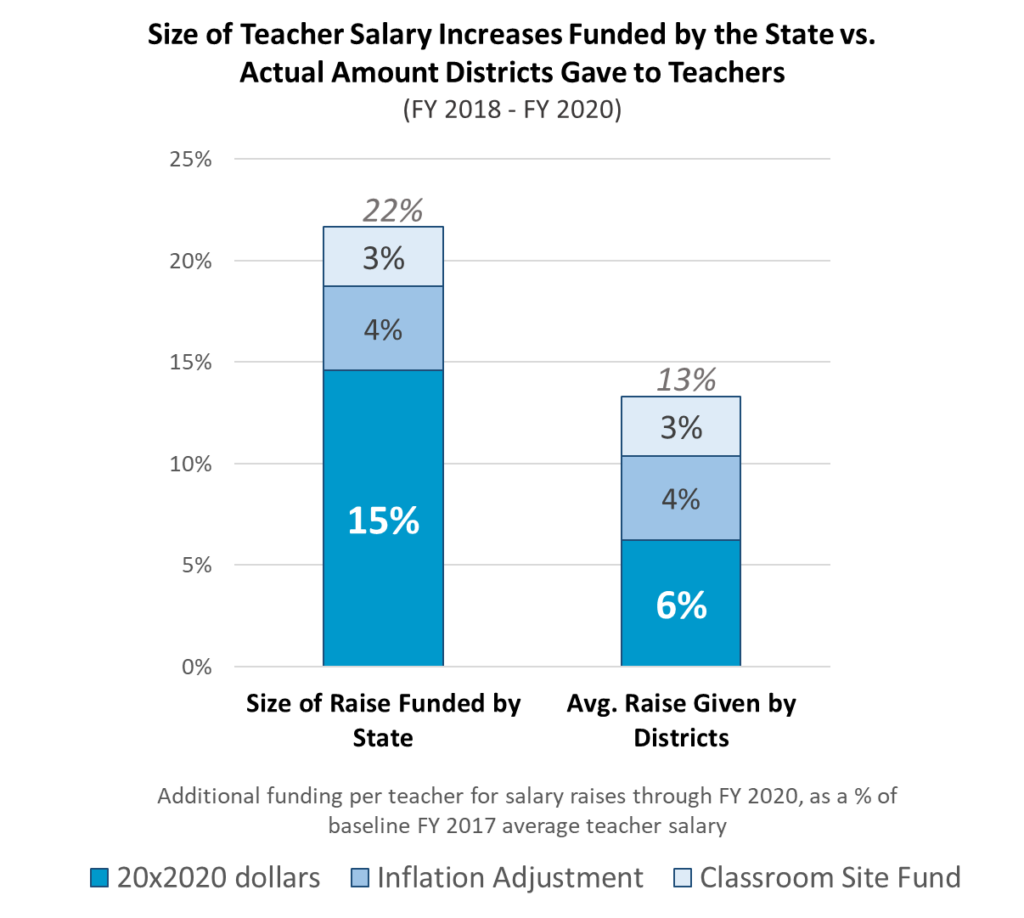New Report: AZ School Districts Reroute Millions that Lawmakers Intended for Teachers
May 12, 2021
By Matt Beienburg
In 2018, Arizona state lawmakers approved the “20×2020” plan to send hundreds of millions of new dollars to public school districts so they could raise average teacher salaries by 20%. But data revealed in a new Goldwater Institute report suggests that most of that money never made it—at least, not to teachers.
As shown in this new Goldwater report, The Truth about Teacher Pay in Arizona: How Arizona School Districts Have Held Back Teacher Salaries, Blamed Lawmakers, and Continually Captured Public Sympathy, school districts used the majority of the new 20×2020 funds simply to replace, rather than add to, existing buckets of state money for teachers (and vice versa). The result: During the 2019-2020 school year alone, teachers received at least $170 million less from their school districts in salary increases than Arizona taxpayers provided for.
How could this be? After all, school districts reported average salary increases of 13.3% through the 2019-2020 school year, just shy of their 15% interim target. Goldwater’s new report shows, however, that most of this increase was already paid for by other automatic state funding increases intended to support teacher pay, which 20×2020 was designed to complement, not replace.
As shown in the report:
- After accounting for the dollars teachers would have received anyway (from state inflation adjustments and from higher state tax sales tax revenues under Proposition 301), districts used their 20×2020 dollars to provide just a 6% ($3,000) raise in average teacher salaries through 2019-2020, far short of the funded target of more than $7,000 for that year.

- School districts have established a decades-long pattern of this behavior: After voters approved the Proposition 301 sales tax increase for K-12 funding in 2000, for example, the state Auditor General found that over the following decade, districts had disregarded the expectations of voters, likely violated state statute by shifting funds away from the classroom, and paid their teachers “about $7,500” less on average than they could have with the new funds.
- Districts have consistently deprioritized teacher pay, even during years of economic growthand record K-12 spending:From the implementation of Proposition 301 in fiscal year 2002 through the pre-Great Recession economic boom for instance, district revenues per pupil increased 11.8% adjusted for inflation, while districts sustained teacher salary increases of just 0.5% over the same period once similarly adjusted for inflation.
- Districts have increased operational spending (adjusted for inflation) in all major expenditure categories between fiscal years 2001 and 2020, yet teacher salaries have failed to rise. District spending on administration, for instance, has risen by nearly $2,000 in inflation-adjusted terms per class of 20 students, even as teacher salaries were no higher through fiscal year 2020.
- Contributing to the downward pressure on teacher salaries, Arizona school districts have added almost 2,000 managers, supervisors, and directors since the 1983-1984 school year. The growth rate of these administrative positions is over 30% higher than that of students and teachers during the same period.
- More recently, despite an unprecedented $4 billion in federal COVID-19 stimulus revenues given to Arizona’s K-12 system and surging district fund balances, Arizona school districts have elected to respond by terminating educators, while the Arizona Department of Education has declined to release up to $85 million dollars as requested by members of the state legislature.
- Taken together, these episodes each fit into a decades-long trend in which district spending on teacher salaries has fallen from 37% to 28% of district budgets since 1980, meaning schools now spend roughly a quarter less on teacher salaries compared to other expenditures than they did just a handful of decades ago.
As previously reported by the Arizona Tax Research Association, state lawmakers’ 20×2020 plan contained enough new funding for Arizona public schools to increase average teacher salaries to the 26th highest in the nation (16th highest when adjusted for the cost of living). Since that time, however, education activists have insisted that Arizona teacher pay remains at the bottom of the barrel, dismissing the hundreds of millions of dollars of additional taxpayer investments as “nothing.”
While these claims have continued to recycle badly outdated figures from the pre-20×2020 period, they may indeed reveal a deeper, more problematic pattern—a seemingly endless cycle in which a) district and union leaders warn of low teacher salaries, b) state lawmakers and/or voters agree to provide massive funding to boost those salaries, and c) the money is ultimately used to instead increase spending in virtually every category except teacher salaries.
State lawmakers—and their constituents—may wish to rethink their participation in this cycle, and they can start by reading more in Goldwater’s new report here.
Matt Beienburg is the Director of Education Policy and the Director of the Van Sittert Center for Constitutional Advocacy at the Goldwater Institute. He is the author of the new Goldwater report The Truth about Teacher Pay in Arizona: How Arizona School Districts Have Held Back Teacher Salaries, Blamed Lawmakers, and Continually Captured Public Sympathy.
Get Connected to Goldwater
Sign up for the latest news, event updates, and more.
Recommended Blogs

Donate Now
Help all Americans live freer, happier lives. Join the Goldwater Institute as we defend and strengthen freedom in all 50 states.
Donate NowSince 1988, the Goldwater Institute has been in the liberty business — defending and promoting freedom, and achieving more than 400 victories in all 50 states. Donate today to help support our mission.

We Protect Your Rights
Our attorneys defend individual rights and protect those who cannot protect themselves.
Need Help? Submit a case.


